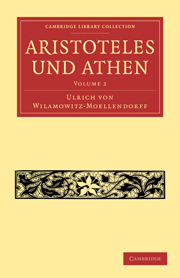Refine search
Actions for selected content:
23990 results in Ancient history
Bibliographical essay
-
- Book:
- Money in Classical Antiquity
- Published online:
- 05 August 2012
- Print publication:
- 18 November 2010, pp 212-216
-
- Chapter
- Export citation
Preface and acknowledgements
-
- Book:
- Money in Classical Antiquity
- Published online:
- 05 August 2012
- Print publication:
- 18 November 2010, pp xiii-xiv
-
- Chapter
- Export citation
List of figures and tables
-
- Book:
- Money in Classical Antiquity
- Published online:
- 05 August 2012
- Print publication:
- 18 November 2010, pp x-xi
-
- Chapter
- Export citation
1 - Monetization: issues
-
- Book:
- Money in Classical Antiquity
- Published online:
- 05 August 2012
- Print publication:
- 18 November 2010, pp 18-34
-
- Chapter
- Export citation
Greek and Roman monetary system and coin denominations
-
- Book:
- Money in Classical Antiquity
- Published online:
- 05 August 2012
- Print publication:
- 18 November 2010, pp xv-xvi
-
- Chapter
- Export citation
Frontmatter
-
- Book:
- Money in Classical Antiquity
- Published online:
- 05 August 2012
- Print publication:
- 18 November 2010, pp i-viii
-
- Chapter
- Export citation
Maps
-
- Book:
- Money in Classical Antiquity
- Published online:
- 05 August 2012
- Print publication:
- 18 November 2010, pp xviii-xxii
-
- Chapter
- Export citation
List of maps
-
- Book:
- Money in Classical Antiquity
- Published online:
- 05 August 2012
- Print publication:
- 18 November 2010, pp xii-xii
-
- Chapter
- Export citation
3 - Monetary networks
-
- Book:
- Money in Classical Antiquity
- Published online:
- 05 August 2012
- Print publication:
- 18 November 2010, pp 65-91
-
- Chapter
- Export citation
2 - Monetization: cases
-
- Book:
- Money in Classical Antiquity
- Published online:
- 05 August 2012
- Print publication:
- 18 November 2010, pp 35-64
-
- Chapter
- Export citation
Appendices
-
- Book:
- Money in Classical Antiquity
- Published online:
- 05 August 2012
- Print publication:
- 18 November 2010, pp -
-
- Chapter
- Export citation
APPENDIX 2
-
- Book:
- Money in Classical Antiquity
- Published online:
- 05 August 2012
- Print publication:
- 18 November 2010, pp 206-208
-
- Chapter
- Export citation
7 - Sacred finance
-
- Book:
- Money in Classical Antiquity
- Published online:
- 05 August 2012
- Print publication:
- 18 November 2010, pp 156-185
-
- Chapter
- Export citation
Glossary
-
- Book:
- Money in Classical Antiquity
- Published online:
- 05 August 2012
- Print publication:
- 18 November 2010, pp 209-211
-
- Chapter
- Export citation
Epilogue: monetary culture
-
- Book:
- Money in Classical Antiquity
- Published online:
- 05 August 2012
- Print publication:
- 18 November 2010, pp 186-198
-
- Chapter
- Export citation
References
-
- Book:
- Money in Classical Antiquity
- Published online:
- 05 August 2012
- Print publication:
- 18 November 2010, pp 217-233
-
- Chapter
- Export citation
Introduction
-
- Book:
- Money in Classical Antiquity
- Published online:
- 05 August 2012
- Print publication:
- 18 November 2010, pp 1-17
-
- Chapter
- Export citation
6 - Prices and price formation: a case study
-
- Book:
- Money in Classical Antiquity
- Published online:
- 05 August 2012
- Print publication:
- 18 November 2010, pp 141-155
-
- Chapter
- Export citation
4 - Cash and credit
-
- Book:
- Money in Classical Antiquity
- Published online:
- 05 August 2012
- Print publication:
- 18 November 2010, pp 92-124
-
- Chapter
- Export citation

Aristoteles und Athen
-
- Published online:
- 10 November 2010
- Print publication:
- 15 July 2010
- First published in:
- 1893
